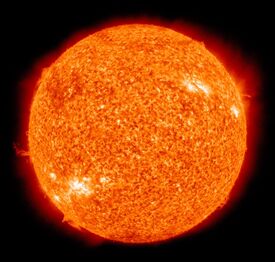TrekkyStar (talk | contribs) No edit summary |
TrekkyStar (talk | contribs) No edit summary |
||
| Line 1: | Line 1: | ||
{{planet |
{{planet |
||
| imageBG= |
| imageBG= |
||
| − | | image=[[File:Sun.jpg| |
+ | | image=[[File:Sun.jpg|275px]] |
| name=Sol (or the Sun) |
| name=Sol (or the Sun) |
||
| hidea= |
| hidea= |
||
Revision as of 17:04, 9 January 2010
| Sun | |
|---|---|

|
Sol (or the Sun) is the star at the center of our solar system. The Earth and other matter (including other planets, asteroids, meteoroids, comets and dust) orbit the Sun, which by itself accounts for more than 99% of the solar system's mass:
Energy from the Sun—in the form of insolation from sunlight—supports almost all life on Earth via photosynthesis, and drives the Earth's climate and weather.
About 74% of the Sun's mass is hydrogen, 25% is helium, and the rest is made up of trace quantities of heavier elements. The Sun is about 4.6 billion years old and is about halfway through its main-sequence evolution, during which nuclear fusion reactions in its core fuse hydrogen into helium. Each second, more than 4 million tonnes of matter are converted into energy within the Sun's core, producing neutrinos and solar radiation. In about 5 billion years, the Sun will evolve into a red giant and then a white dwarf, creating a planetary nebula in the process.
The Sun is a magnetically active star; it supports a strong, changing magnetic field that varies year-to-year and reverses direction about every eleven years. The Sun's magnetic field gives rise to many effects that are collectively called solar activity, including sunspots on the surface of the Sun, solar flares, and variations in the solar wind that carry material through the solar system. The effects of solar activity on Earth include auroras at moderate to high latitudes, and the disruption of radio communications and electric power. Solar activity is thought to have played a large role in the formation and evolution of the solar system, and strongly affects the structure of Earth's outer atmosphere.
Although it is the nearest star to Earth and has been intensively studied by scientists, many questions about the Sun remain unanswered, such as why its outer atmosphere has a temperature of over a million K while its visible surface (the photosphere) has a temperature of just 6,000 K. Current topics of scientific enquiry include the sun's regular cycle of sunspot activity, the physics and origin of solar flares and prominences, the magnetic interaction between the chromosphere and the corona, and the origin of the solar wind.

Clouded Sunset.
| |||
|---|---|---|---|
| The Sun · Mercury · Venus · Earth · Mars · Ceres* · Jupiter · Saturn · Uranus · Neptune · Pluto* · Haumea* · Makemake* · Eris* · Dwarf Planet Candidates* | |||
| Planets · Dwarf Planets · Moons: Terran · Martian · Asteroidal
· Jovian · Saturnian · Uranian · Neptunian · Plutonian · Eridian | |||
| 'Ceres * Pluto * Haumea * Makemake * Eris | |||
| Small bodies: Meteoroids · Asteroids (Asteroid belt) · Centaurs · TNOs (Kuiper belt/Scattered disc) · Comets (Oort Cloud) | |||
| Hypothetical Bodies: Vulcan · Planet 9 · Planet 10 · Tyche · Nibiru · Nemesis · more... | |||
| Planets with '*' are dwarf planets. | |||
| See also astronomical objects and the solar system's list of objects, sorted by radius or mass. |
